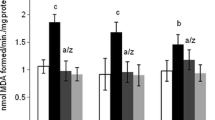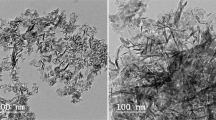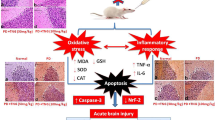Abstract
Aluminum (Al) had well-identified adverse influences on the nervous system mainly through the creation of reactive oxygen species (ROS). Melatonin works as an antioxidant through the inhibition of ROS and attenuating peroxidation of lipids. Nuclear factor (erythroid-derived 2)-like 2 (Nrf2) is a pivotal transcription factor which controls the transcription of antioxidant enzymes. This study was conducted to determine the potential neuroprophylactic impacts of melatonin in aluminum chloride (AlCl3)-initiated neurotoxicity including potential mechanism(s) of action and relevant signaling in rats. Thirty-six male rats were distributed into 4 groups: Control; AlCl3 (50 mg/kg bwt, i.p, 3 times weekly for 3 months); melatonin (5 mg/kg bwt, i.p daily for 2 weeks before AlCl3 and sustained for the next 3 months); and melatonin with AlCl3. Neuronal alterations were histopathologically and biochemically evaluated. The neuronal antioxidant-related genes and relevant Nrf2 protein expression were determined by real-time PCR and Western blotting, respectively. The current data showed a substantial increase in brain damage biomarkers, acetylecholinesterase (AchE) activity, and malondialdehyde (MDA) content while the enzymatic antioxidant expression as glutathione-s-transferase (GST), catalase (CAT), and superoxide dismutase (SOD) were substantially attenuated in the aluminum-treated group, with cleared histopathological changes as inflammatory cell infiltration with neuronal degeneration. Supplementation of melatonin resulted in an obvious amelioration in all previous abnormal alteration observed in AlCl3-treated rats rather than increased Al burden and/or altered Fe and Cu homeostasis with upregulating both total and phosphorylated Nrf2 expression. Therefore, the study concluded that melatonin has a potential ability to be neuroprophylactic against Al-induced neurotoxic effect and oxidative damage in the rat brain through upregulating and instigating Nrf2 signaling apart from metal chelation.



Similar content being viewed by others
References
ADTG Wagener F, Scharstuhl A, M Tyrrell R, Von den Hoff JW, Jozkowicz A, Dulak J, Russel GMF, Marie Kuijpers-Jagtman A (2010) The heme-heme oxygenase system in wound healing; implications for scar formation. Current Drug Targets 11:1571–1585
Almohawes ZN (2017) Protective effect of melatonin on gentamicin induced hepatotoxicity in rats. J Pharmacol Toxicol 12:129–135
Alshabanah OA, Hafez MM, Al-Harbi MM, Hassan ZK, Al Rejaie SS, Asiri YA, Sayed-Ahmed MM (2010) Doxorubicin toxicity can be ameliorated during antioxidant L-carnitine supplementation. Oxidative Med Cell Longev 3:428–433
Anane R, Creppy E (2001) Lipid peroxidation as pathway of aluminium cytotoxicity in human skin fibroblast cultures: prevention by superoxide dismutase+ catalase and vitamins E and C. Human Exp Toxicol 20:477–481
Apopa PL, He X, Ma Q (2008) Phosphorylation of Nrf2 in the transcription activation domain by casein kinase 2 (CK2) is critical for the nuclear translocation and transcription activation function of Nrf2 in IMR-32 neuroblastoma cells. J Biochem Mol Toxicol 22:63–76
Bala M (2014) Concerted action of Nrf2-ARE pathway, MRN complex, HMGB1 and inflammatory cytokines-implication in modification of radiation damage. Redox Biol 2:832–846
Bhadauria M (2012) Combined treatment of HEDTA and propolis prevents aluminum induced toxicity in rats. Food Chem Toxicol 50:2487–2495
Bihaqi SW, Sharma M, Singh AP, Tiwari M (2009) Neuroprotective role of Convolvulus pluricaulis on aluminium induced neurotoxicity in rat brain. J Ethnopharmacol 124:409–415
Bourogaa E, Nciri R, Mezghani-Jarraya R, Racaud-Sultan C, Damak M, El Feki A (2013) Antioxidant activity and hepatoprotective potential of Hammada scoparia against ethanol-induced liver injury in rats. J Physiol Biochem 69:227–237
Celi P (2010) The role of oxidative stress in small ruminants’ health and production. Rev Bras Zootec 39:348–363
Collins JF, Prohaska JR, Knutson MD (2010) Metabolic crossroads of iron and copper. Nutr Rev 68:133–147
Das TK, Wati MR, Fatima-Shad K (2015) Oxidative stress gated by Fenton and Haber Weiss reactions and its association with Alzheimer’s disease. Arch Neurosci 2
de Vries HE, Witte M, Hondius D, Rozemuller AJ, Drukarch B, Hoozemans J, van Horssen J (2008) Nrf2-induced antioxidant protection: a promising target to counteract ROS-mediated damage in neurodegenerative disease? Free Radic Biol Med 45:1375–1383
Ellman GL, Courtney KD, Andres V Jr, Featherstone RM (1961) A new and rapid colorimetric determination of acetylcholinesterase activity. Biochem Pharmacol 7:88–95
Farina M, Rotta LN, Soares FA, Jardim F, Jacques R, Souza DO, Rocha JB (2005) Hematological changes in rats chronically exposed to oral aluminum. Toxicology 209:29–37
Fatima SK, Prabhavathi PA, Padmavathi P, Reddy P (2001) Analysis of chromosomal aberrations in men occupationally exposed to cement dust. Mutat Res Genet Toxicol Environ Mutagen 490:179–186
Gonzalez MA, del Lujan Alvarez M, Pisani GB, Bernal CA, Roma MG, Carrillo MC (2007) Involvement of oxidative stress in the impairment in biliary secretory function induced by intraperitoneal administration of aluminum to rats. Biol Trace Elem Res 116:329–348
Gulcin İ, Buyukokuroglu ME, Kufrevioglu OI (2003) Metal chelating and hydrogen peroxide scavenging effects of melatonin. J Pineal Res 34:278–281
Jomova K, Valko M (2011) Advances in metal-induced oxidative stress and human disease. Toxicology 283:65–87
Julka D, Vasishta R, Gill K (1996) Distribution of aluminum in different brain regions and body organs of rat. Biol Trace Elem Res 52:181–192
Kaizer RR, Corrêa MC, Spanevello RM, Morsch VM, Mazzanti CM, Gonçalves JF, Schetinger MR (2005) Acetylcholinesterase activation and enhanced lipid peroxidation after long-term exposure to low levels of aluminum on different mouse brain regions. J Inorg Biochem 99:1865–1870
Kilkenny C, Browne W, Cuthill IC, Emerson M, Altman DG (2010) Animal research: reporting in vivo experiments: the ARRIVE guidelines. Br J Pharmacol 160:1577–1579
Kumar V, Gill KD (2014) Oxidative stress and mitochondrial dysfunction in aluminium neurotoxicity and its amelioration: a review. Neurotoxicology 41:154–166
Lebda MA, Sadek KM, Abouzed TK, Tohamy HG, El-Sayed YS (2018) Melatonin mitigates thioacetamide-induced hepatic fibrosis via antioxidant activity and modulation of proinflammatory cytokines and fibrogenic genes. Life Sci 192:136–143
Malekshah AK, Torabizadeh Z, Naghshwar F (2005) Developmental toxicity of aluminum from high doses of AICI3 in mice. J Appl Res Clin Exp Ther 5:575
Manubolu M, Goodla L, Ravilla S, Thanasekaran J, Dutta P, Malmlöf K, Obulum VR (2014) Protective effect of Actiniopteris radiata (Sw.) Link. against CCl4 induced oxidative stress in albino rats. J Ethnopharmacol 153:744–752
Maruyama S, Hirayama C (2001) Yamamato et all. Red blood cell status in alcoholic and non-alcoholic liver diseases. J Lab Med 138:332–337
Mohamed Sadek K (2012) Antioxidant and immunostimulant effect of carica papaya linn. aqueous extract in acrylamide intoxicated rats. Acta Inform Med 20:180–185
Nedzvetsky VS, Tuzcu M, Yasar A, Tikhomirov A, Baydas G (2006) Effects of vitamin E against aluminum neurotoxicity in rats. Biochem Mosc 71:239–244
Nehru B, Anand P (2005) Oxidative damage following chronic aluminium exposure in adult and pup rat brains. J Trace Elem Med Biol 19:203–208
Newairy A-SA, Salama AF, Hussien HM, Yousef MI (2009) Propolis alleviates aluminium-induced lipid peroxidation and biochemical parameters in male rats. Food Chem Toxicol 47:1093–1098
Ng T, Gao W, Li L, Niu S, Zhao L, Liu J, Shi L, Fu M, Liu F (2005) Rose (Rosa rugosa)-flower extract increases the activities of antioxidant enzymes and their gene expression and reduces lipid peroxidation. Biochem Cell Biol 83:78–85
Niu Q, Yang Y, Zhang Q, Niu P, He S, Di Gioacchino M, Conti P, Boscolo P (2007) The relationship between Bcl-2 gene expression and learning & memory impairment in chronic aluminum-exposed rats. Neurotox Res 12:163–169
Ohkawa H, Ohishi N, Yagi K (1979) Assay for lipid peroxides in animal tissues by thiobarbituric acid reaction. Anal Biochem 95:351–358
Ramakrishnan R, Elangovan P, Pari L (2017) Protective role of tetrahydrocurcumin: an active polyphenolic curcuminoid on cadmium-induced oxidative damage in rats. Appl Biochem Biotechnol 183:51–69
Reiter RJ, Tan D-X, Fuentes-Broto L (2010) Melatonin: a multitasking molecule, progress in brain research. Elsevier, pp 127–151
Ren W, Liu G, Chen S, Yin J, Wang J, Tan B, Wu G, Bazer FW, Peng Y, Li T (2017) Melatonin signaling in T cells: functions and applications. J Pineal Res 62
Rodriguez C, Mayo JC, Sainz RM, Antolin I, Herrera F, Martin V, Reiter RJ (2004) Regulation of antioxidant enzymes: a significant role for melatonin. J Pineal Res 36:1–9
Sadek KM (2012) Barley phenolic compounds impedes oxidative stress in lead acetate intoxicated rabbits. Oxid Antioxid Med Sci 1:141–146
Sadek KM (2014) Chemotherapeutic efficacy of an ethanolic Moringa oleifera leaf extract against chromium-induced testicular toxicity in rats. Andrologia 46:1047–1054
Sadek KM, Shaheen H (2014) Biochemical efficacy of vitamin D in ameliorating endocrine and metabolic disorders in diabetic rats. Pharm Biol 52:591–596
Sadek K, Abouzed T, Nasr S (2015) Lycopene modulates cholinergic dysfunction, Bcl-2/Bax balance, and antioxidant enzymes gene transcripts in monosodium glutamate (E621) induced neurotoxicity in a rat model. Can J Physiol Pharmacol 94:394–401
Sadek K, Beltagy D, Saleh E, Abouelkhair R (2016) Camel milk and bee honey regulate profibrotic cytokine gene transcripts in liver cirrhosis induced by carbon tetrachloride. Can J Physiol Pharmacol:1–10
Sadek KM, Abouzed TK, Abouelkhair R, Nasr S (2017a) The chemo-prophylactic efficacy of an ethanol Moringa oleifera leaf extract against hepatocellular carcinoma in rats. Pharm Biol 55:1458–1466
Sadek KM, Lebda MA, Abouzed TK, Nasr SM, Shoukry M (2017b) Neuro- and nephrotoxicity of subchronic cadmium chloride exposure and the potential chemoprotective effects of selenium nanoparticles. Metab Brain Dis 32:1659–1673
Sadek KM, Lebda MA, Nasr SM, Shoukry M (2017c) Spirulina platensis prevents hyperglycemia in rats by modulating gluconeogenesis and apoptosis via modification of oxidative stress and MAPK-pathways. Biomed Pharmacother 92:1085–1094
Sadek KM, Saleh EA, Nasr SM (2018) Molecular hepatoprotective effects of lipoic acid against carbon tetrachloride-induced liver fibrosis in rats: hepatoprotection at molecular level. Hum Exp Toxicol 37:142–154
Saravanan M, Kumar KP, Ramesh M (2011) Haematological and biochemical responses of freshwater teleost fish Cyprinus carpio (Actinopterygii: Cypriniformes) during acute and chronic sublethal exposure to lindane. Pestic Biochem Physiol 100:206–211
Schubert D, Dargusch R, Raitano J, Chan S-W (2006) Cerium and yttrium oxide nanoparticles are neuroprotective. Biochem Biophys Res Commun 342:86–91
Sedlak J (1963) Determination of sulfhydriyl groups in biological samples. Anal Biochem 25:192–205
Sharma DR, Wani WY, Sunkaria A, Kandimalla RJ, Verma D, Cameotra SS, Gill KD (2013) Quercetin protects against chronic aluminum-induced oxidative stress and ensuing biochemical, cholinergic, and neurobehavioral impairments in rats. Neurotox Res 23:336–357
Strong MJ, Garruto RM, Joshi JG, Mundy WR, Shafer TJ (1996) Can the mechanisms of aluminum neurotoxicity be integrated into a unified scheme? J Toxicol Environ Health A 48:599–614
Sutken E, Aral E, Ozdemir F, Uslu S, Alatas O, Colak O (2007) Protective role of melatonin and coenzyme Q10 in ochratoxin A toxicity in rat liver and kidney. Int J Toxicol 26:81–87
Taha N, Korshom M, Mandour A, Sadek K (2013a) Effects of garlic and acrylamide on some antioxidant enzymes. Glob J Med Plant Res 1:190–194
Taha N, Korshom M, Mandour A, Sadek K (2013b) Lipoic acid impedes markers of oxidative stress in the liver of streptozotocin-diabetic rats. Glob J Med Plant Res 1:195–198
Taha N, Sadek K, Korshom M, Mandour A (2013c) The green tea improve the oxidative status in stereptozotocin-induced diabetic rats. J Curr Res Sci 1:79
Tahan V, Ozaras R, Canbakan B, Uzun H, Aydin S, Yildirim B, Aytekin H, Ozbay G, Mert A, Senturk H (2004) Melatonin reduces dimethylnitrosamine-induced liver fibrosis in rats. J Pineal Res 37:78–84
Taïr K, Kharoubi O, Taïr OA, Hellal N, Benyettou I, Aoues A (2016) Aluminium-induced acute neurotoxicity in rats: treatment with aqueous extract of Arthrophytum (Hammada scoparia). J Acute Dis 5:470–482
Yokel RA, McNamara PJ (2001) Aluminium toxicokinetics: an updated minireview. Basic Clin Pharmacol Toxicol 88:159–167
Zhang J-J, Meng X, Li Y, Zhou Y, Xu D-P, Li S, Li H-B (2017) Effects of melatonin on liver injuries and diseases. Int J Mol Sci 18:673
Zhao J, Zhang B, Li S, Zeng L, Chen Y, Fang J (2014) Mangiferin increases Nrf2 protein stability by inhibiting its ubiquitination and degradation in human HL60 myeloid leukemia cells. Int J Mol Med 33:1348–1354
Author information
Authors and Affiliations
Corresponding author
Additional information
Responsible editor: Philippe Garrigues
Publisher’s note
Springer Nature remains neutral with regard to jurisdictional claims in published maps and institutional affiliations.
Rights and permissions
About this article
Cite this article
Sadek, K.M., Lebda, M.A. & Abouzed, T.K. The possible neuroprotective effects of melatonin in aluminum chloride-induced neurotoxicity via antioxidant pathway and Nrf2 signaling apart from metal chelation. Environ Sci Pollut Res 26, 9174–9183 (2019). https://doi.org/10.1007/s11356-019-04430-9
Received:
Accepted:
Published:
Issue Date:
DOI: https://doi.org/10.1007/s11356-019-04430-9




